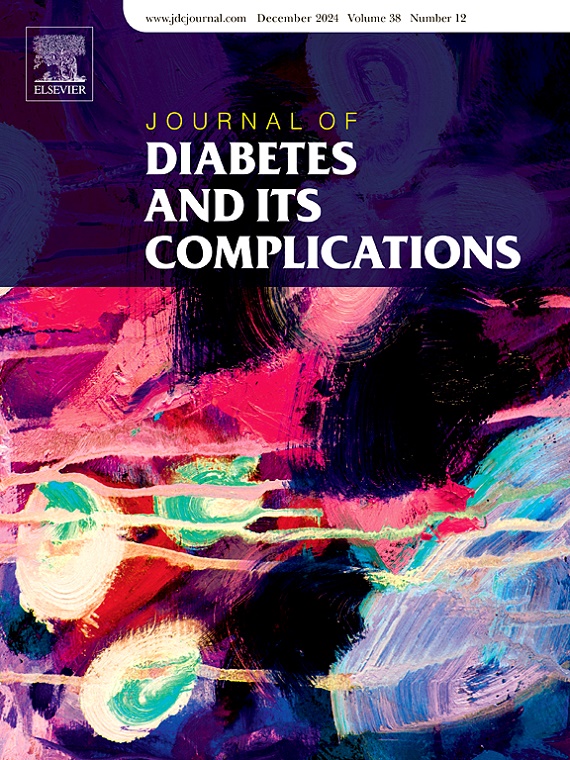Evaluating the effect of Semaglutide as add-on therapy on glycemic control and continuous glucose monitoring outcomes in adults with type 1 diabetes: A two-year real-world data study
IF 3.1
3区 医学
Q3 ENDOCRINOLOGY & METABOLISM
引用次数: 0
Abstract
Aims
To evaluate the long-term efficacy of a GLP-1 receptor agonist (GLP-1RA, Semaglutide) as an adjunct to insulin therapy in adults with type 1 diabetes (T1D), using continuous glucose monitoring (CGM) metrics alongside weight and metabolic outcomes.
Methods
In this retrospective chart review of adults with T1D on intensive insulin therapy, GLP-1RA was initiated and maintained for two years. Glycemic and metabolic parameters were evaluated at baseline, 12 months (T12), and 24 months (T24) during combination therapy.
Results
A total of 67 adults with T1D (56.7 % males, 43.3 % females; mean age 31.8 years, SD: 6.11; mean diabetes duration 16.6 years, SD: 5.16) were included. By 24 months, we observed improved %TIR70–180 from 46 % to 71 % and %TIR70–140 from 28.1 % to 47.9 % (p < 0.001 for both). GRI, including CHypo and CHyper, showed sustained reductions, and glycemic variability improved, with CV% falling from 46.3 % to 33.6 % (p < 0.001). HbA1c improved from 8.2 % to 7.1 %, with total daily insulin dose decreasing from 1.4 to 0.7 IU/kg/day (p < 0.001). Body weight and lipid profile improved, with significant reductions in weight (p < 0.001), LDL (p < 0.001), and triglycerides (p < 0.05). No hospitalizations for DKA or major adverse cardiovascular events (MACE) occurred, and short discontinuation had no significant impact on metabolic or glycemic outcomes.
Conclusions
The adjunctive use of GLP-1RA in T1D shows potential for improving glycemic stability and metabolic parameters without increasing hypoglycemia risk. However, further studies are needed to confirm these effects across diverse populations and over more extended periods to fully establish their long-term efficacy and safety.
评估西马鲁肽作为附加治疗对成人1型糖尿病患者血糖控制和持续血糖监测结果的影响:一项为期两年的真实世界数据研究
目的评估GLP-1受体激动剂(GLP-1RA, Semaglutide)作为成人1型糖尿病(T1D)胰岛素治疗的辅助治疗的长期疗效,使用连续血糖监测(CGM)指标以及体重和代谢结果。方法对接受胰岛素强化治疗的成人T1D患者进行回顾性分析,GLP-1RA启动并维持2年。在联合治疗期间,分别在基线、12个月(T12)和24个月(T24)评估血糖和代谢参数。结果成人T1D患者共67例,其中男性56.7%,女性43.3%;平均年龄31.8岁,SD: 6.11;平均糖尿病病程16.6年,SD: 5.16)。24个月后,我们观察到% TIR70-180从46%提高到71%,% TIR70-140从28.1%提高到47.9% (p <;两者均为0.001)。GRI(包括CHypo和CHyper)持续下降,血糖变异性得到改善,CV%从46.3%降至33.6% (p <;0.001)。HbA1c从8.2%降至7.1%,每日胰岛素总剂量从1.4 IU/kg/天降至0.7 IU/kg/天(p <;0.001)。体重和血脂得到改善,体重显著降低(p <;0.001), LDL (p <;0.001),甘油三酯(p <;0.05)。没有因DKA住院或主要不良心血管事件(MACE)发生,短期停药对代谢或血糖结局没有显著影响。结论在T1D患者中辅助使用GLP-1RA可改善血糖稳定性和代谢参数,但不会增加低血糖风险。然而,需要进一步的研究来证实这些影响在不同人群和更长的时间内,以充分确定其长期有效性和安全性。
本文章由计算机程序翻译,如有差异,请以英文原文为准。
求助全文
约1分钟内获得全文
求助全文
来源期刊

Journal of diabetes and its complications
医学-内分泌学与代谢
CiteScore
5.90
自引率
3.30%
发文量
153
审稿时长
16 days
期刊介绍:
Journal of Diabetes and Its Complications (JDC) is a journal for health care practitioners and researchers, that publishes original research about the pathogenesis, diagnosis and management of diabetes mellitus and its complications. JDC also publishes articles on physiological and molecular aspects of glucose homeostasis.
The primary purpose of JDC is to act as a source of information usable by diabetes practitioners and researchers to increase their knowledge about mechanisms of diabetes and complications development, and promote better management of people with diabetes who are at risk for those complications.
Manuscripts submitted to JDC can report any aspect of basic, translational or clinical research as well as epidemiology. Topics can range broadly from early prediabetes to late-stage complicated diabetes. Topics relevant to basic/translational reports include pancreatic islet dysfunction and insulin resistance, altered adipose tissue function in diabetes, altered neuronal control of glucose homeostasis and mechanisms of drug action. Topics relevant to diabetic complications include diabetic retinopathy, neuropathy and nephropathy; peripheral vascular disease and coronary heart disease; gastrointestinal disorders, renal failure and impotence; and hypertension and hyperlipidemia.
 求助内容:
求助内容: 应助结果提醒方式:
应助结果提醒方式:


